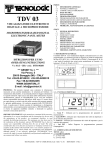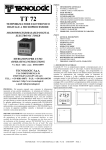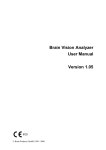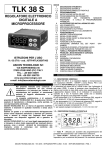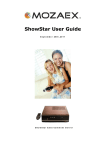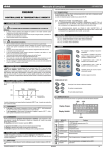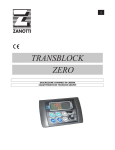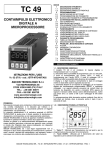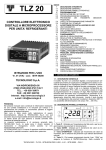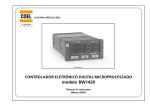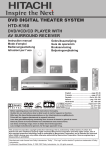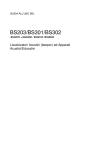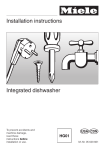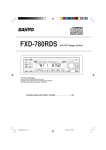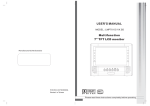Download Technologic TDH02
Transcript
TDH 02 REGOLATORE ELETTRONICO DIGITALE A MICROPROCESSORE MICROPROCESSOR-BASED DIGITAL ELECTRONIC CONTROLLER ISTRUZIONI PER L'USO OPERATING INSTRUCTIONS Vr. 01 (I - GB) - cod.: ISTR 00540 TECNOLOGIC S.p.A. INDICE 1 1.1 1.2 2 3 4 4.1 4.2 4.3 4.4 5 5.1 5.2 5.3 6 6.1 7 DESCRIZIONE GENERALE PANNELLO FRONTALE CODIFICA DELLO STRUMENTO DATI TECNICI INSTALLAZIONE FUNZIONAMENTO REGOLATORE ON/OFF REGOLATORE A ZONA NEUTRA REGOLATORE PID E FUNZIONE DI AUTOTUNING FUNZIONE SET POINT DINAMICO PROGRAMMAZIONE IMPOSTAZIONE DEL SET POINT PROGRAMMAZIONE DEI PARAMETRI IMPOSTAZIONE DEI LIMITI DI INGRESSO DESCRIZIONE DEI PARAMETRI TABELLA PARAMETRI PROBLEMI , MANUTENZIONE E GARANZIA INDEX 1 1.1 1.2 2 3 4 4.1 4.2 4.3 4.4 5 5.1 5.2 5.3 6 6.1 7 GENERAL DESCRIPTION FRONT PANEL INSTRUMENT CODE TECHNICAL DATA INSTALLATION OPERATING MODE ON/OFF CONTROL NEUTRAL ZONE CONTROL PID CONTROL AND AUTOTUNING FUNCTION DYNAMIC SET POINT FUNCTION PROGRAMMING PROGRAMMING OF SET-POINT PROGRAMMING OF PARAMETERS PROGRAMMING OF INPUT LIMITS DESCRIPTION OF PARAMETERS PARAMETERS TABLE TROUBLES, MAINTENANCE, GUARANTEE VIA INDIPENDENZA 56 27029 VIGEVANO (PV) ITALY TEL.: ++39 0381 69871 - FAX: ++39 0381 698730 internet : http:\\www.tecnologic.it e-mail: [email protected] 1 - DESCRIZIONE GENERALE Il modello TDH 02 è un regolatore digitale a microprocessore con 1 o 2 Set point, regolazione ON/OFF, PID o a ZONA NEUTRA e con funzione di AUTOTUNING per la regolazione PID. Il valore di processo viene visualizzato su 3 display rossi mentre lo stato delle uscite viene segnalato da due led. Lo strumento prevede 1 o 2 uscite, a relè o per il pilotaggio di relè statici (SSR) e un ingresso per sonde di temperatura del tipo PTC (KTY 81-121), o RTD (Pt100 o Ni100), o Termocoppie (J, K, S) o per PREMESSA: Nel presente manuale sono contenute le informazioni sonde di qualsiasi tipo aventi uscita normalizzata in corrente o in tensione necessarie ad una corretta installazione e le istruzioni per l'utilizzo e la 4..20 mA, 0..20 mA o 0..10 V. manutenzione del prodotto, si raccomanda pertanto di leggere attentamente le seguenti istruzioni. Ogni cura è stata posta nella realizzazione di questa documentazione, tuttavia la TECNOLOGIC S.p.A. non può assumersi alcuna responsabilità derivante dall'utilizzo della stessa. Lo stesso dicasi per ogni persona o società coinvolta nella creazione del presente manuale. La presente pubblicazione è di esclusiva proprietà della TECNOLOGIC S.p.A. la quale pone il divieto assoluto di riproduzione e divulgazione, anche parziale, se non espressamente autorizzata. La TECNOLOGIC S.p.A. si riserva di apportare modifiche estetiche e funzionali in qualsiasi momento e senza alcun preavviso. PREVIOUS STATEMENT: In this manual are contained all the necessary information for a correct installation and the instructions for the use and the maintenance of the product; we recommend, therefore, to read 1.1 carefully the following instructions. The maximum care has been used in the realisation of this document, anyway TECNOLOGIC S.p.A. does not assume any responsibility deriving from the use of itself. The same consideration has to be done for each person or Company involved in the creation of this manual. The herewith issue is an exclusive property of TECNOLOGIC S.p.A. which forbids any reproduction and divulgation, although partial, if not expressly authorised. TECNOLOGIC S.p.A. reserves the right to execute aesthetically and functional modifications, at any moment and without any notice. - PANNELLO FRONTALE TECNOLOGIC - TDH 02 USER MANUAL (I - GB) - Vr. 01 - ISTR 00540 - PAG. 1 1 - Tasto P : Utilizzato per l'impostazione del set point e per la TABELLA RANGE DI MISURA programmazione dei parametri di funzionamento PROBE 3 DIGIT 3 DIGIT with D.P. 2 - Tasto DOWN : Utilizzato per il decremento dei valori da impostare o -50 ... +150 °C -9.9 ... +99.9 °C PTC per la selezione dei parametri -58 ... +302 °F -9.9 ... +99.9 °F 3 - Tasto UP : Utilizzato per l'incremento dei valori da impostare o per la -99 ... +600 °C -9.9 ... +99.9 °C Pt 100 (Pt) selezione dei parametri -99 ... +999 °F -9.9 ... +99.9 °F 4 - Led OUT1 : Indica lo stato dell'uscita OUT1 on (acceso), off (spento) e -50 ... +150 °C -9.9 ... +99.9 °C Ni 100 (ni) l'ingresso in programmazione Set1 o parametri (lampeggiante). -58 ... +302 °F -9.9 ... +99.9 °F 5 - Led OUT2 : Indica lo stato dell'uscita OUT2 on (acceso), off (spento) e 0 ... +800 °C --tc J (FE) l'ingresso in programmazione Set2 +32 ... 999 °F 0 ... +999 °C --tc K (Cr) 1.2 - CODIFICA DELLO STRUMENTO +32 ... +999 °F TDH 02 a b c d ee 0 ... +999 °C --tc S (rh) a = ALIMENTAZIONE +32 ... +999 °F F : 12 VAC/VDC - 99 ... 999 -9.9 ... 99.9 4..20 mA, 0..20 mA, G : 24 VAC/VDC 0..10 V (gener.) b = INGRESSO C : Termocoppie (J, K, S) 3 - INSTALLAZIONE D : Termoresistenze (Pt100, Ni100 IEC) MONTAGGIO MECCANICO: Lo strumento, in contenitore 33 x 75 mm, E : Termistori PTC (KTY 81) è concepito per il montaggio ad incasso a pannello. Praticare quindi un foro F : Segnali normalizzati 4..20 mA 29 x 71 mm ed inserirvi lo strumento fissandolo con l'apposita staffa A : Segnali normalizzati 0..20 mA fornita. Si raccomanda di montare l'apposita guarnizione per ottenere il V : Segnali normalizzati 0..10 V grado di protezione frontale IP 65. Evitare di collocare la parte interna c = USCITA OUT1 dello strumento in luoghi soggetti ad alta umidità o sporcizia. Installare lo R : A relè strumento il più lontano possibile da fonti che possono generare disturbi O : Uscita in tensione 12 VDC per SSR elettromagnetici e quindi anche da motori, teleruttori, relè, elettrovalvole d = USCITA OUT2 ecc. R : A relè COLLEGAMENTI ELETTRICI: Effettuare le connessioni collegando O : Uscita in tensione 12 VDC per SSR un solo conduttore per morsetto e seguendo lo schema riportato, - : Uscita non presente controllando che la tensione di alimentazione sia quella indicata sullo ee = CODICI SPECIALI strumento e che l'assorbimento degli attuatori collegati allo strumento non sia superiore alla corrente massima consentita. Lo strumento, essendo 2 - DATI TECNICI previsto per collegamento permanente entro un'apparecchiatura, non è CARATTERISTICHE ELETTRICHE dotato di dispositivi interni di protezione da sovracorrenti, si raccomanda Alimentazione: 12, 24 VAC/VDC +/- 10% pertanto di proteggere adeguatamente tutti i circuiti connessi allo strumento Frequenza AC: 50/60 Hz con dispositivi (es. fusibili) adeguati alle correnti circolanti. Si raccomanda Assorbimento: 3 VA circa di utilizzare cavi con isolamento appropriato alle tensioni e alle temperature Ingresso/i: 1 ingresso. Per sonde di temperatura tc J, K, S o RTD Pt 100 di esercizio e di fare in modo che i cavi degli ingressi siano tenuti distanti IEC, Ni 100 o PTC (KTY 81-121 990 Ω a 25 °C) o per segnali dai cavi di alimentazione e da altri cavi di potenza. Se il cavo degli ingressi normalizzati 4..20 mA, 0..20 mA o 0..10 V è schermato è preferibile collegarlo a terra da un solo lato. Si consiglia di Uscita/e: Sino a 2 uscite. A relè (8A-AC1, 3A-AC3 250 VAC) ; o in controllare che i parametri impostati siano quelli desiderati prima di tensione per pilotaggio SSR (12 VDC/25 mA) collegare le uscite agli attuatori onde evitare anomalie o danneggiamenti Uscita alimentazione ausiliaria: (solo segn norm.) 12 VDC / 25 mA Max. dell'impianto controllato. Qualora un guasto dell'apparecchio possa creare Vita elettrica uscite a relè: 100000 operaz. situazioni pericolose o dannose si ricorda che l'impianto deve essere Classe di protezione contro le scosse elettriche: Frontale in Classe II predisposto con dispositivi elettromeccanici aggiuntivi per garantire la Isolamenti: Rinforzato tra parti in bassa tensione (uscite a relè) e frontale; sicurezza. Per l'alimentazione dell'apparecchio si raccomanda l'uso Rinforzato tra parti in bassa tensione (uscite a relè) e parti in bassissima dell'apposito trasformatore TCTR, o di trasformatore con caratteristiche tensione (alimentazione e ingresso); Nessun isolamento tra alimentazione, equivalenti, e di utilizzare un trasformatore per ogni apparecchio. ingresso e uscite statiche CARATTERISTICHE MECCANICHE Contenitore: Plastico autoestinguente UL 94 V0 Dimensioni: 33 x 75 mm, prof. 64 mm Peso: 110 g circa Installazione: Incasso a pannello in foro 29 x 71 mm Connessioni: Morsetti a vite 2,5 mm2 Grado di protezione frontale: IP 65 con guarnizione Situazione di polluzione: Normale Temperatura ambiente di funzionamento: 0 ... 55 °C Umidità ambiente di funzionamento: 30 ... 95 RH% senza condensazione Temperatura di trasporto e immagazzinaggio: -10 ... +60 °C CARATTERISTICHE FUNZIONALI Regolazione: ON/OFF, ZONA NEUTRA, PID Range di misura: Secondo la sonda utilizzata (vedi tabella) Risoluzione visualizzazione: Secondo la sonda utilizzata. 1/0,1/5/0,5 Precisione totale: +/- 0,5 % fs Velocità di acquisizione: 1 acquisizione al secondo Azione: tipo 1C secondo EN 60730-1 Conformita':Direttiva CEE EMC 89/336 (EN 50081-1, EN 50082-1), Direttiva CEE BT 73/23 e 93/68 (EN 60730-1) TECNOLOGIC - TDH 02 USER MANUAL (I - GB) - Vr. 01 - ISTR 00540 - PAG. 2 4 - FUNZIONAMENTO 4.1 - REGOLATORE ON/OFF Il modo di regolazione dello strumento di tipo ON/OFF agisce sulle uscite in funzione dei Set point impostati, dei differenziali di intervento (par. "d1"e "d2") e dei modi di funzionamento (par. "HC1"e "HC2") programmati. Per un corretto funzionamento programmare un differenziale negativo per un controllo di tipo inverso (es. Riscaldamento) e positivo per un controllo di tipo diretto (es. Refrigerazione). I due Set possono essere impostati inoltre come indipendenti o dipendenti tramite il parametro Legame Set ("OCO"), in quest'ultimo caso il Set effettivo di regolazione dell'uscita 2 sarà [Set1+Set2]. Se l'uscita 2 è utilizzata come allarme si ricorda che il funzionamento come allarme relativo o assoluto è stabilito dal par. "OCO" (in=assoluto, di=relativo) e l'allarme di minima o di massima dal par. "HC2" (H=minima, C=massima). Inoltre il funzionamento del regolatore può essere modificato tramite il parametro di ritardo uscite (par. "od") o la funzione di Set Point Dinamico di seguito descritta. 4.2 - REGOLATORE A ZONA NEUTRA Il funzionamento a Zona Neutra riguarda entrambe le uscite e serve in genere per il controllo degli impianti che possiedono un elemento che causa un incremento positivo (ad es. Riscaldante, Umidificante ecc.) e un elemento che causa un incremento Negativo (ad es. Refrigerante, Deumidificante ecc.). Il funzionamento di regolazione è determinato dal Set 1 (il Set 2 viene automaticamente disabilitato) e dalla Zona Neutra (par. "db"). Il regolatore si comporta nel seguente modo: spegne le uscite quando il valore di processo raggiunge il Set e attiva l'uscita OUT1 quando il valore di processo è minore a [Set1-db], oppure accende l'uscita OUT2 quando il valore di processo è maggiore a [Set1+db]. Quindi l'elemento che causa incremento Positivo andrà collegato all'uscita OUT 1 mentre l'elemento di incremento negativo andrà collegato all'uscita OUT 2. AUTOTUNING che permette la sintonizzazione dello strumento per la regolazione PID in maniera automatica. Per attuare la funzione di AUTOTUNIG procedere come segue: - Impostare il Set point desiderato - Impostare i parametri di funzionamento desiderati ed in particolare "HC1" - Impostare il parametro "Ft" come "Pi" - Collegare lo strumento all'impianto comandato - Impostare il parametro "tun" come "y" - Attendere l'uscita dalla programmazione parametri A questo punto la funzione di Autotuning è attivata e viene segnalata dal lampeggiamento del valore di processo sul display. Il regolatore attua quindi una serie di operazioni sull'impianto collegato al fine di calcolare i parametri della regolazione PID più idonei. Attendere sempre il termine del processo di Autotuning, segnalato dal ritorno del display al funzionamento normale, per poter spegnere lo strumento. La durata del processo di Autotuning è limitata ad un massimo di 4 ore. Nel caso in cui il processo non sia terminato nell'arco di 4 ore lo strumento visualizzerà "EEE". Per interrompere il ciclo di Autotuning o ripristinare il funzionamento normale dopo un errore spegnere e riaccendere lo strumento. I valori calcolati saranno memorizzati automaticamente dallo strumento al termine dell'esecuzione del ciclo di Autotuning nei parametri relativi alla regolazione PID. 4.4 - FUNZIONE SET POINT DINAMICO La funzione Set Point Dinamico agisce solo sull'uscita OUT 1 ed è utilizzabile per prevenire sovraelongazioni iniziali eccessive del valore di processo a causa dell'inerzia del sistema o quando si desidera un graduale raggiungimento del valore di Set. Tramite questa funzione si ottiene automaticamente un aumento progressivo nel tempo del Set Point di regolazione dal valore di processo all'accensione dello strumento al valore di Set impostato. I parametri da impostare per tale funzione sono: "drb" : Semibanda simmetrica a cavallo del Set Point al di fuori della quale è attivata la funzione di Set Point Dinamico. "dSI" : Valore di incremento del Set tra due istanti successivi stabiliti. "dSt" : Tempo che deve intercorrere tra due successivi incrementi di Set Point. La funzione di Set Point Dinamico viene disabilitata impostando dSi = 0. 5 - PROGRAMMAZIONE 4.3 - REGOLATORE PID E FUNZIONE DI AUTOTUNING La regolazione PID può avvenire solo mediante l'uscita OUT 1 mentre l'uscita OUT 2 può lavorare con regolazione ON/OFF con SET 2 indipendente o dipendente dal SET 1, e quindi può essere utilizzata come allarme (vedi regolazione ON/OFF). L'algoritmo di regolazione dello strumento prevede l'impostazione dei seguenti parametri: Per il termine PROPORZIONALE: "Pb" - Banda Proporzionale "rSt" - Reset manuale o Offset della banda proporzionale "Ct" - Tempo di ciclo dell'uscita. Per il termine INTEGRALE: "It" - Tempo Integrale Per il termine DERIVATIVO: "dt" - Tempo derivativo Lo strumento è impostato in fabbrica con i parametri relativi alla regolazione PID su valori standard. Qualora questi non dovessero risultare ottimali per la regolazione si consiglia di attivare la funzione di 5.1 - IMPOSTAZIONE DEI SET POINT Premere il tasto P quindi rilasciarlo, il led OUT1 lampeggierà e il display visualizzerà il SET1 impostato. Per modificarlo agire sui tasti UP per incrementare il valore o DOWN per decrementarlo. Questi tasti agiscono a passi di un digit ma se mantenuti premuti oltre un secondo il valore si incrementa o decrementa in modo veloce, e dopo due secondi nella stessa condizione la velocità aumenta ulteriormente per consentire il rapido raggiungimento del valore desiderato. Premendo ancora il tasto P e rilasciandolo il led OUT2 lampeggierà e verrà visualizzato il SET2 impostato che potrà essere modificato agendo sui tasti UP e DOWN come già descritto. L'uscita dal modo di impostazione del set avviene automaticamente non agendo su alcun tasto per circa 5 secondi, a quel punto il display tornerà a visualizzare il valore di processo. 5.2 - PROGRAMMAZIONE DEI PARAMETRI Per avere accesso ai parametri di funzionamento dello strumento occorre premere il tasto P e mantenerlo premuto per circa 5 secondi, trascorsi i quali il led OUT1 lampeggierà e il display visualizzerà il codice che identifica il primo parametro. A questo punto è possibile rilasciare il tasto TECNOLOGIC - TDH 02 USER MANUAL (I - GB) - Vr. 01 - ISTR 00540 - PAG. 3 P e agendo sui tasti UP o DOWN selezionare il parametro desiderato. Una volta selezionato il parametro sul quale si intende operare premere il tasto P e mantenerlo premuto, verrà quindi visualizzato il valore impostato. Per modificare tale valore mantenere sempre premuto il tasto P e agire contemporaneamente sui tasti UP o DOWN. Una volta impostato il valore desiderato rilasciare il tasto P e il display mostrerà nuovamente la sigla del parametro selezionato. Agendo sui tasti UP o DOWN è quindi possibile selezionarne un altro e modificarlo come descritto. Per uscire dal modo di programmazione non agire su alcun tasto per circa 20 secondi, lo strumento si riporterà automaticamente al modo di funzionamento normale visualizzando il valore di processo. Attendere sempre l'uscita dalla fase di programmazione poichè se lo strumento viene spento prima dell'uscita tutti i dati inseriti durante l'ultima sessione non saranno memorizzati. N.B.: Nella programmazione dei parametri può accadere che alcuni parametri descritti non vengono visualizzati, questo avviene perchè lo strumento è predisposto per non visualizzare automaticamente i parametri non necessari. 5.3 - IMPOSTAZIONE DEI LIMITI DI INGRESSO Se lo strumento è predisposto con ingresso per segnali normalizzati 4..20 mA, 0..20 mA o 0..10 V è necessario impostare i limiti di ingresso per la corretta visualizzazione della misura. Ad esempio se la sonda da collegare ha un range 0..100 bar sarà necessario impostare 0 come al parametro "Lci" ( riferimento minimo o inizio scala) e 100 al parametro "Hci" (riferimento massimo o fine scala). Analogamente se si decide di avere una visualizzazione con punto decimale occorrerà modificare detti parametri. Ad esempio se lo strumento è collegato ad una sonda di umidità con un range 20..99 %RH e si decide di visualizzare la grandezza con il punto decimale occorrerà prima impostare il par. "dP" come "on" e successivamente i parametri "Lci" a 20.0 e "Hci" a 99.9. Lci LIMITE INFERIORE INGRESSO PER SEGNALI NORMALIZZATI : Valore che lo strumento deve visualizzare quando al circuito di ingresso è presente il valore minimo (4 mA, 0 mA, 0 V). Hci - LIMITE SUPERIORE INGRESSO PER SEGNALI NORMALIZZATI:Valore che lo strumento deve visualizzare quando al circuito di ingresso è presente il valore massimo (20 mA, 10 V). CAL - CALIBRAZIONE: Offset positivo o negativo che viene sommato al valore letto dalla sonda prima della visualizzazione alla quale è legato anche il funzionamento di regolazione. Questo parametro può rendersi necessario per una ritaratura dello strumento. Ft - TIPO DI REGOLAZIONE: Permette di selezionare uno dei possibili modi di regolazione che lo strumento offre: ON/OFF (on), PID (Pi) o Zona Neutra (nr). PSE - SONDA IN INGRESSO: Permette di selezionare, se il modello dello strumento è per termocoppie o per termoresistenze, vari eventuali tipi di sonda in ingresso: per termocoppie J (FE), K (Cr) , S (rh) e per termoresistenze Pt100 (Pt), Ni100 (ni). Al cambio di questo parametro si raccomanda di attendere l'uscita dalla fase di progammazione e quindi di spegnere e riaccendere lo strumento. OCO - LEGAME SET: Permette di stabilire se i due Set devono essere indipendenti o se il Set2 deve essere considerato relativo al Set1 (in=indipendenti, di=dipendenti). HC1 - MODO DI FUNZIONAMENTO USCITA 1: Stabilisce se l'uscita OUT1 deve funzionare con azione inversa (es. Riscaldamento, Umidificazione ecc.) oppure con azione diretta ( es. Refrigerazione, Deumidificazione ecc.) (H=inversa, C=diretta). HC2 - MODO DI FUNZIONAMENTO USCITA 2: Stabilisce se l'uscita OUT2 deve funzionare con azione inversa (es. Riscaldamento, Umidificazione ecc.) oppure con azione diretta ( es. Refrigerazione, Deumidificazione ecc.) (H =inversa, C=diretta). dP - PUNTO DECIMALE: Permette di inserire il punto decimale nella visualizzazione e quindi di stabilire la risoluzione del display (1 o 0,1) ma non il Set, i limiti del Set (par. "LS", "HS") e i limiti di ingresso (par. "Lci", "Hci") che devono essere modificati manualmente. Per esempio se il Set era 20 e viene inserito il punto decimale il Set sarà 2.0 (on= con punto decimale, oF=senza punto decimale). (disponibile solo nei modelli con ingresso PTC, RTD o per segnali normalizzati) rou - UNITA' DI MISURA: Stabilisce, per misure di temperatura, la visualizzazione in gradi Centigradi o Fahrenheit. Si fa presente che la modifica di questo parametro modifica la visualizzazione del display ma non il Set ed i limiti del Set (per. "LS" e "HS") impostati, che devono essere modificati manualmente. Ad esempio se il Set era 50 °C e viene cambiata l'unità di misura il Set sarà 50 °F. tun - AUTOTUNING: Parametro di selezione per effettuare un ciclo di Autotuning, che permette il calcolo automatico dei parametri di regolazione PID (n=no autotuning, y=start autotuning). hdd APPROSSIMAZIONE ULTIMA CIFRA: Permette l'approssimazione della cifra meno significativa. In quest'ultima infatti, se inserita la funzione, verrà visualizzato 0 se il valore effettivo è compreso tra 0 e 4, oppure 5 se il valore è compreso tra 5 e 9. Ad esempio se la funzione è inserita e la misura fatta dallo strumento risulta essere 78 il display visualizzerà 75, oppure se la misura è 70.3 il display visualizzerà 70.0 (n=senza approssimazione, y=con approssimazione). tAb - PARAMETRO NON MODIFICABILE 6 - DESCRIZIONE DEI PARAMETRI Di seguito vengono descritti tutti i parametri di cui lo strumento può essere dotato, si fa presente che alcuni di essi potranno non essere presenti o perchè dipendono dal tipo di strumento utilizzato o perchè sono automaticamente disabilitati in quanto parametri non necessari. d1- DIFFERENZIALE DI INTERVENTO 1: Valore tra attivazione e disattivazione rispetto al Set1 dell'uscita OUT1. d2- DIFFERENZIALE DI INTERVENTO 2: Valore tra attivazione e disattivazione rispetto al Set2 dell'uscita OUT2. db - ZONA NEUTRA: Valore che rappresenta la semibanda della Zona Neutra posta a cavallo del Set1 nel modo di funzionamento omonimo. LS1 - SET MINIMO 1: Valore minimo impostabile come Set1 o limite inferiore del Set1. LS2 - SET MINIMO 2: Valore minimo impostabile come Set2 o limite inferiore del Set2. HS1 - SET MASSIMO 1: Valore massimo impostabile come Set1 o limite superiore del Set1. HS2 - SET MASSIMO 2: Valore massimo impostabile come Set2 o limite superiore del Set2. Pb - BANDA PROPORZIONALE: Ampiezza della banda intorno al Set1 nella quale interviene la regolazione proporzionale. It - TEMPO INTEGRALE: Tempo integrale da impostare nell'algoritmo di regolazione PID. dt - TEMPO DERIVATIVO: Tempo derivativo da impostare nell'algoritmo 6.1 - TABELLA PARAMETRI di regolazione PID. Par. Descrizione rSt - RESET MANUALE: Valore di Offset per la banda proporzionale. Differenziale 1 d1 od - RITARDO USCITE: Ritardo da quando la regolazione richiede una Differenziale 2 d2 variazione dello stato delle uscite a quando questo avviene realmente, sia per l'attivazione che per la disattivazione (in sec.). Il ritardo non è operante db Zona neutra sull'uscita OUT 1 nel modo di regolazione PID. Ct - TEMPO DI CICLO : Tempo di ciclo per l'uscita OUT1 quando LS1 Set minimo 1 interviene la regolazione proporzionale nel modo di regolazione PID. drb - BANDA RESTART SET DINAMICO: Semibanda simmetrica a LS2 Set minimo 2 cavallo del Set che stabilisce la zona al di fuori della quale interviene il funzionamento del Set dinamico. HS1 Set massimo 1 dSI - INCREMENTO SET DINAMICO: Valore di incremento del Set HS2 Set massimo 2 point dinamico tra due istanti successivi stabiliti dal par. "dSt". dSt - INTERVALLO INCREMENTO SET DINAMICO: Intervallo di Pb Banda proporzionale tempo tra un incremento del Set dinamico e il successivo (in sec.). Range Probe limit Def. -1 Probe limit -1 1/0,1 ... Probe limit 1 Probe limit min. Probe limit min. Probe limit Max. Probe limit Max. 1/0,1 ... Probe limit 40 TECNOLOGIC - TDH 02 USER MANUAL (I - GB) - Vr. 01 - ISTR 00540 - PAG. 4 Note It Tempo integrale 0 ... 999 sec. 300 dt Tempo derivativo 0 ... 999 sec. 30 rSt Reset manuale Probe limit 0 od Ritardo uscite 0 ... 500 sec. 0 Ct Tempo di ciclo 1 ... 500 sec. 20 drb Banda restart Set Dinamico 0 ... Probe limit 0 dSI Incremento Set Dinamico 0 ... Probe limit 0 dSt Intervallo incremento Set Dinamico Limite inferiore ingresso per segnali normalizzati Limite superiore ingresso per segnali normalizzati 1 ... 999 sec. 1 -99 ... 999 -99 -99 ... 999 999 -99 ... +999 0 on - Pi - nr Pi Lci Hci CAL Calibrazione Ft PSE Tipo di regolazione Sonda in ingresso Tc: FE - Cr - rh Tc: FE Rtd: Pt - Ni Rtd: Pt di - in in OCO Legame set dP Modo di funzionamento uscita OUT1 Modo di funzionamento uscita OUT2 Punto decimale rou Unità di misura tun hdd HC1 HC2 tAb 1.1 - FRONT PANEL H-C H H-C H on - oF oF °C - °F °C Autotuning y-n n Approssimazione ultima cifra Parametro non modificabile y-n n --- --- 7 - PROBLEMI, MANUTENZIONE E GARANZIA SEGNALAZIONI DI ERRORE: Lo strumento prevede la visualizzazione dei messaggi di errore sonda "EEE" , in caso la sonda sia interrotta o in overrange, oppure "- - -" nel caso la sonda (PTC, RTD o per segnali normalizzati) sia in cortocircuito o in underrange, in tal caso verificare la corretta connessione della sonda con lo strumento e successivamente procedere alla verifica della stessa. Nelle condizioni di errore tutte le uscite sono disattivate. PULIZIA: Si raccomanda di evitare l'utilizzo di detergenti abrasivi o contenenti solventi che possono danneggiare lo strumento. GARANZIA E RIPARAZIONI: Lo strumento è garantito da vizi di costruzione o difetti di materiale riscontrati entro i 12 mesi dalla data di consegna. La garanzia si limita alla riparazione o la sostituzione del prodotto. L'eventuale apertura del contenitore, la manomissione dello strumento o l'uso e l'installazione non conforme del prodotto comporta automaticamente il decadimento della garanzia. In caso di prodotto difettoso in periodo di garanzia o fuori periodo di garanzia contattare l'ufficio vendite TECNOLOGIC per ottenere l'autorizzazione alla spedizione. Il prodotto difettoso, quindi , accompagnato dalle indicazioni del difetto riscontrato, deve pervenire con spedizione in porto franco presso lo stabilimento TECNOLOGIC salvo accordi diversi. 1 - GENERAL DESCRIPTION TDH 02 is a digital microprocessor based controller with 1 or 2 set point, ON/OFF, PID or NEUTRAL ZONE mode and with AUTOTUNING function for PID mode. The process value is visualised on 3 red displays and the outputs state is indicated by 2 leds. The instrument has 1 or 2 outputs relay or for solid state relay (SSR) driving and 1 input for PTC (KTY 81), or RTD (Pt 100 or NI100), or Thermocouple (J-K-S) temperature probes or for any kind of probe having normalised output in current (4..20 mA, 0..20 mA) or voltage (0..10 V). 1 - Key P : Used for the set point setting and to program the functioning parameters 2 - Key DOWN : Used to decrease the values or to select parameters 3 - Key UP : Used to increase the values or to select parameters 4 - Led OUT1 : Signalize when the output OUT1 is on (on) or off (off) and signalize the set point 1 or the parameters programming mode (flashing) 5 - Led OUT2 : Signalize when the output OUT2 is on (on) or off (off) and signalize the set point 2 programming mode (flashing) 1.2 - INSTRUMENT CODE TDH 02 a b c d ee a = SUPPLY F : 12 VAC/VDC G : 24 VAC/VDC b = INPUT C : Termocouples (J, K, S) D : Termoresistances (Pt100, Ni100 IEC) E : Termistors PTC (KTY 81) F : Normalized signals 4..20 mA A : Normalized signals 0..20 mA V : Normalized signals 0..10 V c = OUTPUT OUT1 R : Relay O : Voltage output 12 VDC for SSR d = OUTPUT OUT2 R : Relay O : Voltage output 12 VDC for SSR - : Output not present ee = SPECIAL CODES 2 - TECHNICAL DATA ELECTRICAL DATA Supply: 12, 24 VAC/VDC +/- 10% Frequency AC: 50/60 Hz Power consumption: 3 VA approx. Input/s: 1 input. For temperature probes tc J, K, S or RTD Pt 100 IEC, Ni 100 or PTC (KTY 81-121 990 Ω at 25 °C) or for normalized signals 4..20 mA, 0..20 mA o 0..10 V Output/s: Up to 2 outputs. Relay (8A-AC1, 3A-AC3 250 VAC) ; or voltage for SSR drive (12 VDC/25 mA) Auxiliary supply output: 12 VDC / 25 mA Max (only for norm. sign..) Electrical life for relay output: 100000 operat. Protection class against electric shock: Class II for Front panel Insulation: Reinforced insulation between the low voltage section (relay outputs) and the front panel; Reinforced insulation between the low TECNOLOGIC - TDH 02 USER MANUAL (I - GB) - Vr. 01 - ISTR 00540 - PAG. 5 voltage section (relay outputs) and the extra low voltage section (supply and input); No insulation between supply, input and output for SSR driving MECHANICAL DATA Housing: Self-extinguishing plastic, UL 94 V0 Dimensions: 33 x 75 mm, depht 64 mm Weight: 110 g approx. Mounting: Flush in panel in 29 x 71 mm hole Connections: 2,5 mm2 screw terminal block Degree of protection of front panel : IP 65 mounted in panel with gasket Pollution situation: Normal Operating temperature: 0 ... 55 °C Operating humidity: 30 ... 95 RH% without condesation Storage temperature: -10 ... +60 °C FUNCTIONAL DATA Control: ON/OFF, NEUTRAL ZONE, PID Measurement range: according to the used probe (see table range) Display resolution: according to the probe used 1/0,1/5/0,5 Overall accuracy: +/- 0,5 % fs Sampling rate: 1 sample per second Action: 1C type according to EN 60730-1 Compliance: ECC directive EMC 89/336 (EN 50081-1, EN 50082-1), ECC 4 - OPERATING MODE directive LV 73/23 and 93/68 (EN 60730-1) MEASUREMENT RANGE TABLE PROBE 3 DIGIT -50 ... +150 °C PTC -58 ... +302 °F -99 ... +600 °C Pt 100 (Pt) -99 ... +999 °F -50 ... +150 °C Ni 100 (ni) -58 ... +302 °F 0 ... +800 °C tc J (FE) +32 ... 999 °F 0 ... +999 °C tc K (Cr) +32 ... +999 °F 0 ... +999 °C tc S (rh) +32 ... +999 °F - 99 ... 999 4..20 mA, 0..20 mA, 0..10 V (gener.) 3 DIGIT with D.P. -9.9 ... +99.9 °C -9.9 ... +99.9 °F -9.9 ... +99.9 °C -9.9 ... +99.9 °F -9.9 ... +99.9 °C -9.9 ... +99.9 °F -------9.9 ... 99.9 3 - INSTALLATION MECHANICAL MOUNTING: The instrument, in case 33 x 75 mm, is designed for panel mounting. Make an hole 29 x 71 mm and insert the instrument, fixing it with the provided special bracket . We recommend to mount the gasket to obtain an IP 65 front protection. Avoid to place the instrument in areas with humidity or dirt. Connect the instrument as far as possible from source of electromagnetic disturbances so as motors, power relays, relays, electrovalves,etc. ELECTRICAL CONNECTIONS: Carry out the electrical wiring connecting only one wire for each terminal , according to the following diagram, check that the power supply is the same as indicated on the instrument and the loads current is not upper than the maximum current admitted. The instrument, being a built in equipment with permanent connection into a cabinet, is not furnished with internal device protecting from overcurrent : it's recommended , therefore, to properly protect all the electric circuits connected to the instrument, with devices (ex. fuses) proportionate to the circulating currents. It's strongly recommended to use cables with proper insulation, according to the working voltages and temperatures. Furthermore, the input cables has to be kept separate from line voltage wiring. If the input cables is screened, it has to be connected on the ground with only one side. It is advisable to check that the parameters are those desired before connecting the outputs to the actuators so as to avoid malfunctioning . Whenever a failure of the instrument could cause dangerous or damaging situations, it should be kept in mind that the plant has to be provided with additional devices to ensure the safety. It's recommended to supply the instrument using the Tecnologic TCTR transformer or equivalent type, and to use one transformer for each instrument. 4.1 - ON/OFF CONTROL The control mode of the instrument by ON/OFF mode occours on the outputs according to the Sets point fixed, to the differential switching points (par. "d1", "d2") and to operating modes (par. "HC1", "HC2") programmed. For a correct functioning it is necessary to set a negative differential switching point for reverse controls (ex.Heating processes) and a positive differential switching point for direct controls (ex.Cooling processes). Furtheremore the two Sets can be programmed independently or dependently throught the parameter Sets Connection ("OCO"), and in the case of set dependentlythe real regulation Set of output 2 will be [Set1+Set2]. If output 2 is used as an alarm output, par. "OCO" determines if the alarm is absolute or relative (in=absolute, di=relative) and par. "HC2" determines if the alarm is low or high (H=low, C=high). The operating mode can be also modified by means of outputs delay parameter (par. "od") or Dynamic Set Point function, see the next chapters for these functions. 4.2 - NEUTRAL ZONE CONTROL The Neutral Zone control mode concerns both outputs and is generally necessary for controllig a plant that possesses an Positive regulation element (ex. Heating, Humidification etc.) and a Negative regulation element (ex. Cooling, Dehumidification etc.) . The functioning is determined by the Set1 (Set2 is automatically disconnected) and Neutral Zone (par. "db"). Subsequently the regulator operates as follows: switches off the outputs when the process value is the same as Set, switch on the output OUT1 when the process value is under as [Set1-db], and switch on the output OUT2 when the process value is upper as [Set1+db]. Thus the Positive regulation element will be connected to output OUT1, while the Negative regulation element is at output OUT2. TECNOLOGIC - TDH 02 USER MANUAL (I - GB) - Vr. 01 - ISTR 00540 - PAG. 6 4.3 - PID CONTROL AND AUTOTUNING FUNCTION PID control mode can only be carried out through output OUT 1 while output OUT 2 can only operates by means of ON/OFF control mode with Set 2 independent or dependended in respect with Set 1 and can therefore be used as an alarm (see ON/OFF regulator). The PID algorithm of the instrument is provided to program the following parameters: For PROPORTIONAL term : "Pb" - Proportional Band, "rst" - Manual reset "Ct" - Cycle time. For INTEGRAL term: "It" - Integral time For DERIVATIVE term: "dt" - Derivative time The instrument is set on parameters relative to PID control of standard value. If ever these should result to be unsuitable it would be advisable to program the AUTOTUNING function. The Autotuning function permits the automatic tuning of the PID instrument parameters. To active the AUTOTUNING function proceed as follows : - Set the desired "Set point". - Set the desired parameters and especially "HC1". - Set the parameter "Ft": Pi - Connect the instrument with the plant - Set the parameter "tun" : y - Wait for the outing from the programmation Now, the Autotuning function is activated and it's shown by the flashing of the process value on the display. The regulator automatically tunes all the right parameters for a correct PID control mode. Before to switch off the instrument always wait for the end of the Autotuning process, indicated by the return of the display on the normal functioning, . The Autotuning procedure has been limited at a maximum time of 4 hours, after this time, if the Autotuning is not completed the instrument automatically get out from the procedure, showing constantly on the display the "EEE" indication. To stop the Autotuning cycle or re-establish the normal functioning after an error, switch off and on the instrument. The calculated values will be automatically memorised by the instrument at the end of the Autotuning cycle, in the PID control parameters. 4.4 - DYNAMIC SET POINT FUNCTION This function is only obtainable throught output OUT 1 and is usefull to avoid starting over-extention of the process value caused by the inertness of the system or when is wished a gradual reaching of Set value. Infact by means of this function an automatic increase in the time of the regulation Set from the power on-process value to the programmed Set is obtained. The parameters to be programmed for this function are: "drb" : Symmetrical semi-band over-lapping the Set outside from which the function is activated. "dSI" : Increment value of dynamic Set between two successive increments of the dynamic Set value. "dSt" : Time lapse between two successive increments of the dynamic Set value. The Dynamic Set Point function is automatically disconnected by setting dSi = 0. 5 - PROGRAMMING 5.1 - PROGRAMMING OF SET-POINTS Press key P then release it, led OUT1 will flash and the SET1 value will be shown on display. To modify press key UP so as to increase value or DOWN so as to decrease it. These keys count one digit at a time but if the keys are pressed for over one second the value increases or decreases fast and after two seconds the speed increases even more, so as to reach the desired value immediately. Pressing key P again and releasing it, led OUT2 will flash and SET2 which was previously set, will be displayed, it can be modified by pressing keys UP or DOWN as already mentioned. The outgoing from the Set programming mode occurs automatically by not pressing any key for about 5 seconds, thus the process value will again be displayed. 5.2 - PROGRAMMING OF PARAMETERS To accede to the operating parameters it is necessary to press key P holding it down for about 5 seconds, afterwhich the led OUT1 will flash and the code of the first parameter will be visualized on the display. At this point key P can be released and by pressing UP or DOWN the desired parameter can be selected. Once the parameter on which we intended to operate has been selected to modify it press P, while holding it down, the set of the parameter will show up. To modify this value keep P pressed while acting on UP or on DOWN so as to increase or decrease the value. Once the desired value has been set release P and the selected parameter code can be read on the display. By pressing UP or DOWN it is therefore possible to choose another one and modify it as previously mentioned. To outgoing from the programming mode no key is to be pressed for about 20 seconds, the instrument will automatically return to normal functioning mode, visualizing the process value. The instrument must not to be switched off during the programming mode otherwise the data inserted in the last session will not be memorized. P.A.: When programming operating parameters some parameters will not displayed, this happens because the instrument is predisposed to automatically not visualize the unnecessary parameters. 5.3 - PROGRAMMING OF INPUT LIMITS If the instrument is provided with input for normalized signals 4..20 mA, 0..20 mA or 0..10 V it is necessary to set input limits to have the correct measure indication. For example: if the probe to connect has a range of 0..100 bar, it will be necessary to program 0 on "Lci" parameter (start scale) and 100 on "Hci" parameter (end scale). At same time, we have to modify the same parameters to have the decimal point. Example: instrument connected with relative humidity probe with 20..99 %RH as range, to have the decimal point it will occour to program "dP" in "on" mode, "Lci" at 20.0 and "Hci" at 99.9. 6 - DESCRIPTION OF PARAMETERS Here following are described all the instrument parameters; pls. note that some of them could do not appear or because are according to the kind of used instrument or because are automatically not qualified, as they're not necessary. d1 - DIFFERENTIAL SWITCHING POINT1: Value between starting and stopping of output OUT1. d2 - DIFFERENTIAL SWITCHING POINT2: Value between starting and stopping of output OUT2. db - NEUTRAL ZONE : Value which represents the semi-band of the Neutral Zone, in the homonymous functioning mode, overlapping Set1. TECNOLOGIC - TDH 02 USER MANUAL (I - GB) - Vr. 01 - ISTR 00540 - PAG. 7 LS1 - MINIMUM SET1: Minimum possible Set point 1 value or lower limit of Set point 1. LS2 - MINIMUM SET2: Minimum possible Set point 2 value or lower limit of Set point 2. HS1 - MAXIMUM SET1: Maximum possible Set point1 value or higher limit of Set point1. HS2 - MAXIMUM SET2: Maximum possible Set point2 value or higher limit of Set point2. Pb - PROPORTIONAL BAND : Amplitude of the band around Set 1 in which proportional control takes place. It - INTEGRAL TIME : Integral time to be set in algorithm of PID control mode. dt - DERIVATIVE TIME: Derivative time to set in algorithm of PID control mode. rSt - MANUAL RESET : Offset value for proportional band. od - OUTPUTs DELAY: Delay from when the control need a variation to the condition of the outputs to when this actually happens (expr. in sec.). Non operating on output Out 1 in PID control mode. Ct - CYCLE TIME: Cycle time of OUT 1 when proportional control takes place in PID control mode. drb - RESTART BAND DYNAMIC SET: Semiband found in the symmetrical zone in respect with Set outside of which intervenes the functioning of the Dynamic Set Point. dSI - DYNAMIC SET INCREMENT: Increment value of dynamic Set Point function between two successive instant determines by the par. dSt. dSt - DYNAMIC SET INCREMENT INTERVAL: Interval between one Dynamic Set Point increment and the next (expr. in sec.). Lci - LOWER NORMALIZED SIGNALS INPUT LIMIT: Value that the instrument must to indicate in correspondance of minumum value (4 mA, 0 mA, 0 V). Hci - HIGHER NORMALIZED SIGNALS INPUT LIMIT: Value that the instrument must to indicate in correspondance of maximum value (20 mA, 10 V). CAL - CALIBRATION: Positive or negative offset which is calculated on probe reading before visualizing and to which the control functioning is also connected. This parameter can be utilized when a recalibration of the instrument is desired. Ft - CONTROL MODE: Allows the selection of one of possible control modes that the instrument offers: ON/OFF (on), PID (Pi) or Neutral Zone (nr). PSE - INPUT PROBE: Allows selecting, if the instrument type is for thermocouples or for thermoresistances, various types of probe: J (FE), K (Cr), S (rh) for thermocouples and Pt100 (Pt), Ni100 (ni) for thermoresistances. On changing this parameter it is to be remember that the exit programming phase is to be carried out first afterwhich the instrument is to be switched off and then on again. OCO - SETS CONNECTION: Determines if the two Sets are to be independent or if Set2 must be considered relative to Set1 (in=independent, di=dependent). HC1 - OUTPUT 1 OPERATING MODE: Determines if the output OUT1 is tocontrol a process which increment is intended as positive or reverse (ex. Heating, Humidification etc.) or a process which increment is intended as negative or direct (ex. Cooling, Dehumidification etc.) (H=reverse , C=direct). HC2 - OUTPUT 2 OPERATING MODE: Determines if the output OUT2 is to control a process which increment is intended as positive or reverse (ex. Heating, Humidification etc.) or a process which increment is intended as negative or direct (ex. Cooling, Dehumidification etc.) (H=reverse , C=direct). dP - DECIMAL POINT : Allows the insertion of the decimal point on the display and therefore to determine resolution of the reading value (1 or 0,1) but not modified the Set, the Set limits (par. "LS", "HS") and the input limits (par. "Lci", "Hci"). Example, if the Set was 20 the new Set will be 2.0 (on= with decimal point, oF=without decimal point).(available only for models provided for PTC, RTD and normalized signals input). rou - UNIT OF MEASUREMENT: Determines the visualization of the temperature in Centigrade or Fahrenheit degree. It is to be remember that the change of this parameter modifies the visualization but not the Set and the Set limit ("LS" and "HS") programmed (eg. if the Set was 50°C and the unit changes, the Set will rest 50°F). tun - AUTOTUNING: Determines the selection of Autotuning function for the automatic setting of PID parameters (n=no autotuning, y=start autotuning). hdd - HALF DIGIT DISPLAY: This parameter allows the approximation of the last digit at right side. Infact when this parameter is in on mode, on this digit will be show 0 when the real measuring value is between 0 and 4, and will be show 5 when the real measuring value is between 5 and 9. For example if the real measure is 78 display will show 75, or if the real measure is 70.3 the display will show 70.0 (n=without approximation, y=with approximation). tAb - FIXED PARAMETER 6.1 - PARAMETERS TABLE Par. Description Differential 1 d1 Range Probe limit Def. -1 d2 Differential 2 Probe limit -1 db Neutral zone 1/0,1 ... Probe limit 1 LS1 Low/minimum set 1 Probe limit min. LS2 Low/minimum set 2 Probe limit min. HS1 High/Maximum set 1 Probe limit Max. HS2 High/Maximum set 2 Probe limit Max. 1/0,1 ... Probe limit 0 ... 999 sec. 40 300 Pb Proportional band It Integral time dt Derivative time 0 ... 999 sec. 30 rSt Manual reset Probe limit 0 od Outputs delay 0 ... 500 sec. 0 Ct Cycle time 1 ... 500 sec. 20 drb Restart band Dynamic Set 0 ... Probe limit 0 dSI Dynamic Set increment 0 ... Probe limit 0 dSt Dynamic Set increment interval Lower limit for normalized signal input Higher limit for normalized signal input 1 ... 999 sec. 1 -99 ... 999 -99 -99 ... 999 999 -99 ... +999 0 on - Pi - nr Pi Lci Hci CAL Calibration Ft PSE Control mode Input probe OCO Sets connection Notes Tc: FE - Cr - rh Tc: FE Rtd: Pt - Ni Rtd: Pt di - in in HC1 Output 1 operating mode H-C H HC2 Output 2 operating mode H-C H dP Decimal point on - oF oF rou Unit of measurement °C - °F °C tun Autotuning y-n n hdd Half digit display y-n n tAb Fixed parameter --- --- 7 - PROBLEMS, MAINTENANCE AND WARRANTY ERRORS SIGNALLING: The instrument shows the error message "EEE" , when the probe is interrupted or in overrange, or "- - -" when the probe (PTC, RTD or normalised signals) is in short-circuit or underrange; in this case verify the correct probe wiring with the TECNOLOGIC - TDH 02 USER MANUAL (I - GB) - Vr. 01 - ISTR 00540 - PAG. 8 instrument and afterward proceed to verify itself. In the error condition all the outputs are disactivated. HOW TO CLEAN: We recommend to avoid abrasive cleaners or containing solvents which could damage the instrument. WARRANTY AND REPAIRS: The instrument is under warranty against construction vices or defected material, noticed within 12 months from delivery date.The warranty is limited to the repairs or to the substitution of the instrument. The eventual opening of the housing, the violation of the instrument or the wrong use and installation of the product means the automatically decay of the warranty. In case of defected instrument, noticed in warranty period or out of warranty, do contact our sales department to obtain the shipment authorisation. The defected product must be shipped to TECNOLOGIC with the detailed description of the failures found and without any fees or charge for Tecnologic, safe different agreements. TECNOLOGIC - TDH 02 USER MANUAL (I - GB) - Vr. 01 - ISTR 00540 - PAG. 9









